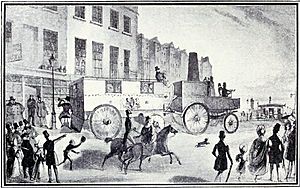Charles Dance (motorist) facts for kids
Sir Charles Dance was an important English inventor and businessman. He lived in the early 1800s. He loved cars that ran on steam power. He helped many engineers who were trying to build and improve these early steam vehicles.
He invested his money in companies that wanted to run steam coaches. These coaches would travel on public roads. He supported an inventor named Goldsworthy Gurney. Sir Charles Dance also built his own steam vehicles.
Contents
Sir Charles Dance and Early Steam Cars
His most famous vehicle was a special coach. It traveled daily from London to Brighton. This coach had an engine on four wheels. It also had a tall, narrow chimney. Above the engine, there were seats for six or seven people. The driver sat there too. Four more passengers could sit on the roof. A footman (an attendant) stood on a board at the back.
This steam carriage was a big attraction in London. Large crowds gathered every day to watch it leave. It was a truly amazing sight for people back then.
Running Steam Coaches
Sir Charles Dance used Gurney's steam coaches. He ran them on the road between Cheltenham and Gloucester. However, people living along the route did not like the coaches. They protested, and he had to stop the service.
After this, he worked with Joshua Field. They created an improved boiler for steam engines. This new boiler was used in the famous coach mentioned earlier.
Journeys and Demonstrations
The first trips with the improved coach happened in September 1833. It pulled a drag (a type of trailer) and an omnibus (a large passenger vehicle). The coach reached a speed of about 26 km/h (16 mph).
On its first trip from London to Brighton, it carried fifteen passengers. The journey was about 84 km (52 mi) long. It took five and a half hours to complete. The return trip was even faster, taking less than five hours.
In mid-October, the steam coach and omnibus were used in London. They ran between Wellington Street near Waterloo Bridge and Greenwich. This service ran for two weeks. Its main purpose was to show the public in London what steam vehicles could do.
Sir Charles Dance did not plan to make this a regular transport service. He wanted to keep the passengers special. So, he charged a high price for tickets. Each ticket cost half a crown for one way.
See also


